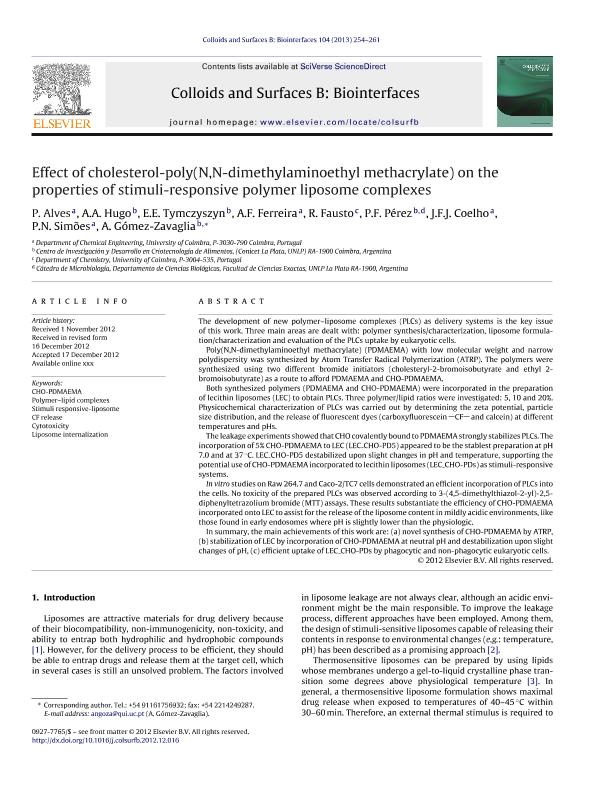Mostrar el registro sencillo del ítem
dc.contributor.author
Alves, P.
dc.contributor.author
Hugo, Ayelen Amelia

dc.contributor.author
Tymczyszyn, Emma Elizabeth

dc.contributor.author
Ferreira, A. F.
dc.contributor.author
Fausto, R.
dc.contributor.author
Perez, Pablo Fernando

dc.contributor.author
Coelho, J. F. J.
dc.contributor.author
Simões, P. N.
dc.contributor.author
Gomez Zavaglia, Andrea

dc.date.available
2016-12-29T13:50:53Z
dc.date.issued
2013-04
dc.identifier.citation
Alves, P.; Hugo, Ayelen Amelia; Tymczyszyn, Emma Elizabeth; Ferreira, A. F. ; Fausto, R.; et al.; Effect of cholesterol-poly(N,N-dimethylaminoethyl methacrylate) on the properties of stimuli-responsive polymer liposome complexes; Elsevier Science; Colloids And Surfaces B: Biointerfaces; 104; 4-2013; 254-261
dc.identifier.issn
0927-7765
dc.identifier.uri
http://hdl.handle.net/11336/10579
dc.description.abstract
The development of new polymer–liposome complexes (PLCs) as delivery systems is the key issue of this work. Three main areas are dealt with: polymer synthesis/characterization, liposome formulation/characterization and evaluation of the PLCs uptake by eukaryotic cells. Poly(N,N-dimethylaminoethyl methacrylate) (PDMAEMA) with low molecular weight and narrow polydispersity was synthesized by Atom Transfer Radical Polymerization (ATRP). The polymers were synthesized using two different bromide initiators (cholesteryl-2-bromoisobutyrate and ethyl 2- bromoisobutyrate) as a route to afford PDMAEMA and CHO-PDMAEMA. Both synthesized polymers (PDMAEMA and CHO-PDMAEMA) were incorporated in the preparation of lecithin liposomes (LEC) to obtain PLCs. Three polymer/lipid ratios were investigated: 5, 10 and 20%. Physicochemical characterization of PLCs was carried out by determining the zeta potential, particle size distribution, and the release of fluorescent dyes (carboxyfluorescein CF and calcein) at different temperatures and pHs. The leakage experiments showed that CHO covalently bound to PDMAEMA strongly stabilizes PLCs. The incorporation of 5% CHO-PDMAEMA to LEC (LEC CHO-PD5) appeared to be the stablest preparation at pH 7.0 and at 37 ◦C. LEC CHO-PD5 destabilized upon slight changes in pH and temperature, supporting the potential use of CHO-PDMAEMA incorporated to lecithin liposomes (LEC CHO-PDs) as stimuli-responsive systems. In vitro studies on Raw 264.7 and Caco-2/TC7 cells demonstrated an efficient incorporation of PLCs into the cells. No toxicity of the prepared PLCs was observed according to 3-(4,5-dimethylthiazol-2-yl)-2,5- diphenyltetrazolium bromide (MTT) assays. These results substantiate the efficiency of CHO-PDMAEMA incorporated onto LEC to assist for the release of the liposome content in mildly acidic environments, like those found in early endosomes where pH is slightly lower than the physiologic. In summary, the main achievements of this work are: (a) novel synthesis of CHO-PDMAEMA by ATRP, (b) stabilization of LEC by incorporation of CHO-PDMAEMA at neutral pH and destabilization upon slight changes of pH, (c) efficient uptake of LEC CHO-PDs by phagocytic and non-phagocytic eukaryotic cells.
dc.format
application/pdf
dc.language.iso
eng
dc.publisher
Elsevier Science

dc.rights
info:eu-repo/semantics/openAccess
dc.rights.uri
https://creativecommons.org/licenses/by-nc-sa/2.5/ar/
dc.subject
Cho-Pdmaema
dc.subject
Polymer-Lipid Complexes
dc.subject
Stimuli Responsive-Liposome
dc.subject
Cytotoxicity
dc.subject
Cf Release
dc.subject
Liposome Internalization
dc.subject.classification
Biología Celular, Microbiología

dc.subject.classification
Ciencias Biológicas

dc.subject.classification
CIENCIAS NATURALES Y EXACTAS

dc.title
Effect of cholesterol-poly(N,N-dimethylaminoethyl methacrylate) on the properties of stimuli-responsive polymer liposome complexes
dc.type
info:eu-repo/semantics/article
dc.type
info:ar-repo/semantics/artículo
dc.type
info:eu-repo/semantics/publishedVersion
dc.date.updated
2016-12-12T14:08:57Z
dc.journal.volume
104
dc.journal.pagination
254-261
dc.journal.pais
Países Bajos

dc.journal.ciudad
Amsterdam
dc.description.fil
Fil: Alves, P.. Universidad de Coimbra; Portugal
dc.description.fil
Fil: Hugo, Ayelen Amelia. Consejo Nacional de Investigaciones Científicas y Técnicas. Centro Científico Tecnológico la Plata. Centro de Investigaciones en Criotecnología de Alimentos (i); Argentina. Universidad Nacional de La Plata; Argentina
dc.description.fil
Fil: Tymczyszyn, Emma Elizabeth. Consejo Nacional de Investigaciones Científicas y Técnicas. Centro Científico Tecnológico la Plata. Centro de Investigaciones en Criotecnología de Alimentos (i); Argentina. Universidad Nacional de La Plata; Argentina
dc.description.fil
Fil: Ferreira, A. F. . Universidad de Coimbra; Portugal
dc.description.fil
Fil: Fausto, R.. Universidad de Coimbra; Portugal
dc.description.fil
Fil: Perez, Pablo Fernando. Consejo Nacional de Investigaciones Científicas y Técnicas. Centro Científico Tecnológico la Plata. Centro de Investigaciones en Criotecnología de Alimentos (i); Argentina. Universidad Nacional de la Plata. Facultad de Ciencias Exactas. Departamento de Ciencias Biologicas; Argentina
dc.description.fil
Fil: Coelho, J. F. J.. Universidad de Coimbra; Portugal
dc.description.fil
Fil: Simões, P. N.. Universidad de Coimbra; Portugal
dc.description.fil
Fil: Gomez Zavaglia, Andrea. Consejo Nacional de Investigaciones Científicas y Técnicas. Centro Científico Tecnológico la Plata. Centro de Investigaciones en Criotecnología de Alimentos (i); Argentina. Universidad Nacional de La Plata; Argentina
dc.journal.title
Colloids And Surfaces B: Biointerfaces

dc.relation.alternativeid
info:eu-repo/semantics/altIdentifier/doi/http://dx.doi.org/10.1016/j.colsurfb.2012.12.016
Archivos asociados
